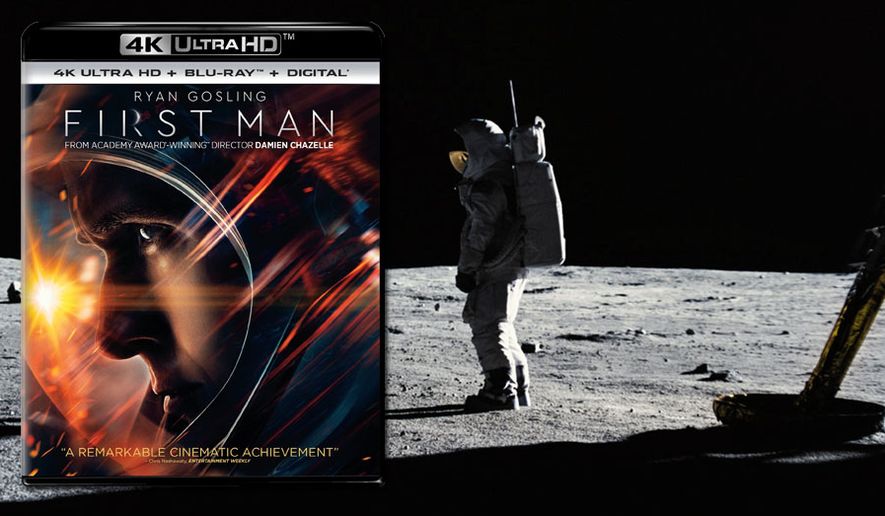One man’s cinematic odyssey to become the first human to walk on the moon jettisons from theater screens to the ultra-high definition realm in First Man (Universal Studios Home Entertainment, rated PG-13, 141 minutes, 2.39:1 and 1.78:1 aspect ratio, $39.98).
Academy Award-winning director of “La La Land” Damien Chazelle manages to pull off a sobering, methodically paced biographical film based on James Hansen’s book about the late Neil Armstrong (played stoically by Ryan Gosling, just like the real man and astronaut).
Covering the years 1961 to 1969, the period piece showcases the emotional complexities of the often-introverted Armstrong, and life with his family and fellow team members, all revealed during many of the Gemini and Apollo missions.
Actors supporting Mr. Gosling include Claire Foy as Armstrong’s first wife Janet; Jason Clarke as astronaut Ed White (who died during an Apollo 1 test); Corey Stoll as Apollo 11 astronaut Buzz Aldrin; and Kyle Chandler as NASA astronaut administrator Deke Slayton.
As far the controversy of not prominently displaying the U.S. flag as Armstrong looks across the moon landing, that was just silly. Clearly throughout the movie, viewers are made well aware that this mission was run by NASA in the United States with the U.S. flag making numerous appearances.
QUIZ: What do you know about the U.S. space program and its astronauts?
The film is really about a man and his family as much about his and his fellow astronauts’ accomplishments and not the nation or the politics overwhelming his endeavor.
“First Man” does not visually dazzle as much as “Gravity,” “Interstellar” or “The Martian” but does offers a very clear picture of the explorer known for defining a moment in history with the simple phrase, “That’s one small step for man, one giant leap for mankind.”
4K in action: I was a bit put off by the grain and some of the blur throughout the film, even though I read that the director stylistically chose to use 16 and 35mm film to immerse viewers in the time frame.
However that footage was mastered to a 2K digital intermediate for theatrical release, which worked fine, but then, for this release, further upscaled to the UHD format.
The results still deliver a rich color pallete throughout with high dynamic range tweaks applied, better than the Blu-ray version for sure, but it makes the 4K clarity, obviously, inconsistent.
What works fantastic for the format, set up by the previous slightly drab visualizations, is the screen-filling moments during the moon landing.
Created for the film’s 65mm IMAX release, it floods a big screen TV with the blackness of space set against the grey lunar surface while watching Armstrong and Mr. Aldrin in eye-popping action.
Throughout, I felt like I was actually part of the mission because of the impeccable detail on spacesuits and cockpit instrumentation and even the dents seen on the lunar module.
The Dolby Atmos soundtrack also shines during any time a spacecraft takes off, especially when witnessing the massive Saturn V rocket exploding off of the launch pad. It really rattled my home entertainment room.
Best extras: All contained on the 4K disc, viewers will first aurally dive into the production nugget rich, optional commentary track with Mr. Chazelle, screenwriter Josh Singer and editor Tim Cross.
It’s a worthy listen as the trio not only covers the production and recreating Armstrong’s life, but they also discuss the level of authentic technical detail applied to the movie.
For example, when creating the X-15 sequence (as seen first in the film) the creators talked to the original pilots that flew the hypersonic, rocket-powered aircraft as well as read original notes and comments during the actual Armstrong flight.
Next, eight featurettes (roughly 30 minutes in total), too briefly cover much of the production through behind-the-scenes footage and interviews with cast and crew that include: the visual effects (spotlighting LED wall technology); the humble hero Neil Armstrong; stunts (lunar lander training); reproducing the moon landing; shooting at original NASA locations; and the actors working with NASA technology.
Obviously, I would have appreciated any level of a much deeper documentary on Armstrong or the early NASA space program.
However, also worth noting is the inclusion of a deleted scene showing Armstrong and his family escaping a nearly fatal fire in their house that really happened.
• Joseph Szadkowski can be reached at jszadkowski@washingtontimes.com.




Please read our comment policy before commenting.